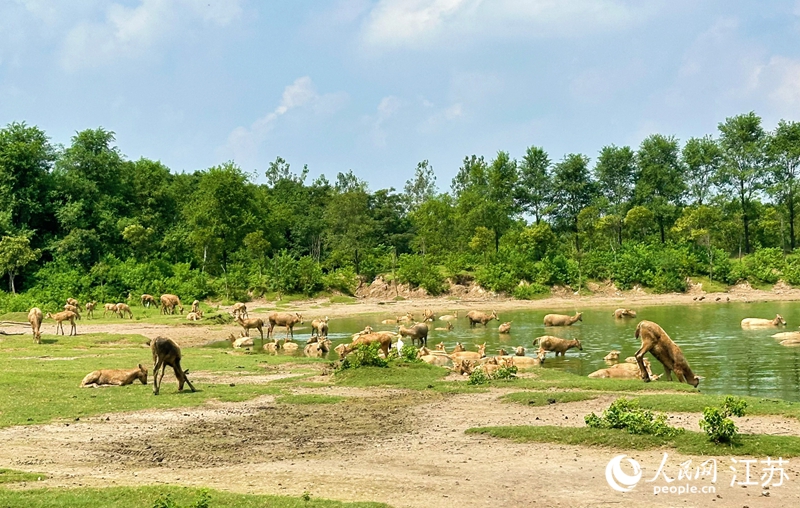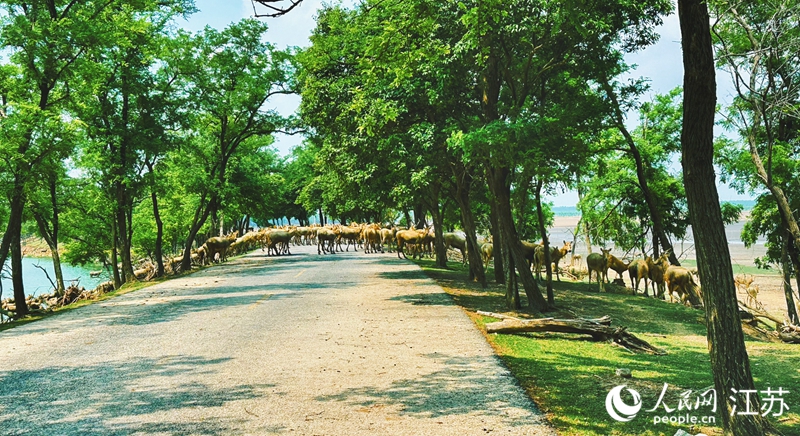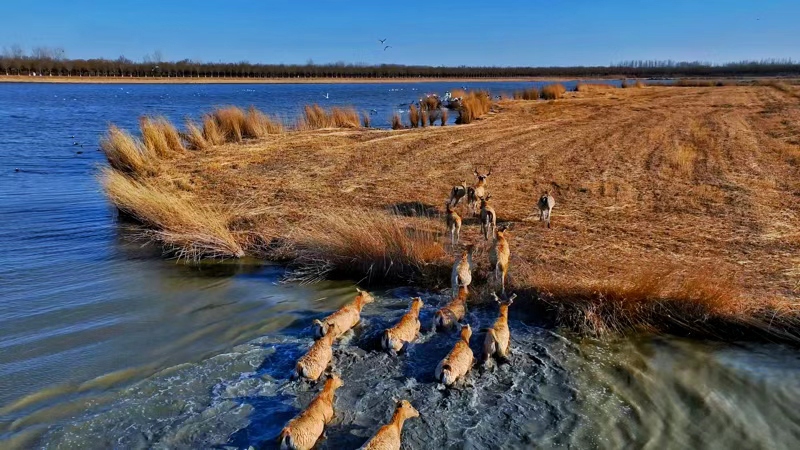




- BRNN
- BRI News
- BRNN News
- Database
Official Documents Polices and Regulations
Inter-government Documents International Cooperation BRI Countries
Business Guide Economic Data BRI Data
Trade
Investment Projects Latest projects
Cases - Content Pool
On an autumn afternoon in Dafeng Milu National Nature Reserve in east China's Jiangsu Province, a sturdy stag raises its head, listening for an approaching feeding truck. Behind it, a herd of milu deer follows. These deer are a first-class protected species in China and are rare animals indigenous to the country.
Research shows that Dafeng district in Yancheng is the birthplace of the milu deer, also known as Pere David's deer. In August 1986, 39 milu deer were returned to China from the United Kingdom, and a nature reserve was established to house them in wetlands along the Yellow Sea in Dafeng district of Yancheng, Jiangsu. Now, 39 years later, the local milu deer population has grown to 8,502, with more than 3,600 living in the wild, representing more than 60 percent of the global population.

Milu deer forage for food at a milu deer park in Dafeng district, Yancheng city, east China's Jiangsu Province. (People's Daily Online/Zhou Mengjiao)
Liu Bin, 43, is the deputy director of the reserve's management office. After earning his doctorate, he joined the reserve as a technician and has worked alongside the deer for 16 years.
The daily sight of feeding the milu deer reminds Liu of his early days at the reserve in 2009. "Back then, there were only about 1,500 milu deer. Most of the feeding was manual and took at least two hours. Now, with mechanized feeding, it's much quicker and easier," he said.
"Milu deer mainly feed on tender grass and tree leaves and are very particular about their diet. They thrive in humid climates with abundant vegetation," Liu said.
"To support their breeding, we supplement their diet during peak calving season from March to June, the antler shedding period around the winter solstice in December, and during winter and spring when plant resources are scarce," he explained. In Area 1, home to more than 1,000 milu deer, around 250 kilograms of feed is given at each session.
Covering about 40,000 mu (2,667 hectares), Dafeng Milu National Nature Reserve is the largest milu deer reserve in the world. It also holds the world's largest wild milu population and gene bank. Since 2017, the reserve has been divided into three core areas: Areas 1 and 2 serve as semi-free-ranging areas, while Area 3 operates as a free-ranging area. The milu deer park in Area 1 has become a popular tourist destination, attracting over 1 million tourist visits last year.
Thanks to meticulous management, the milu deer population in the reserve has grown rapidly since 2017, doubling from 4,101 to its current size.

A herd of wild milu deer moves from shallow water onto the beach near a coastal highway in Dafeng Milu National Nature Reserve in Dafeng district, Yancheng city, east China's Jiangsu Province. (People's Daily Online/Zhou Mengjiao)
"Milu deer are timid by nature and need to keep at least 20 meters away from people," Liu said while patrolling the reserve. Spotting a herd in the distance, he switches off the engine and, as always, looks for No. 236, the first milu deer in the reserve to be bottle-fed from birth.
Five years ago, No. 236 lost its mother during a difficult birth. In 2023, during a wild release, it was the first to step out of the enclosure, and today it still leads a herd in the free-ranging area.
The free-ranging area is separated from the semi-free-ranging areas by a 6-kilometer stainless steel fence.
"The aim is to let milu deer return to nature and restore their wild populations," Liu explained. Since 1998, the reserve has released milu deer into the wild every year, and the wild population now exceeds 3,600.
Compared with the semi-free-ranging areas, the free-ranging area is more challenging, making daily patrols vital. The reserve has two patrol stations, with staff going out almost every day. They count deer, monitor their health and reproduction, and regularly collect feces and water samples for laboratory testing.

Milu deer play in Qilihai Wetland Nature Reserve in north China's Tianjin Municipality. (Photo courtesy of the interviewee)
Just after White Dew, a solar term marking when dew forms and temperatures begin to drop, which fell on Sept. 7 this year, Liu called a technical staff member at Qilihai Wetland Nature Reserve in north China's Tianjin Municipality to advise on winter preparations.
On March 19, 58 milu deer were relocated from Dafeng Milu National Nature Reserve to the Qilihai Wetland Nature Reserve, where they will soon face their first winter.
"The milu deer have adapted well, and the herds are thriving," Liu said. For the past six months, the two reserves have maintained contact with monthly updates. Liu was reassured to hear that the milu deer were doing well at Qilihai.
Since the 1990s, Dafeng Milu National Nature Reserve has been working to relocate milu deer. In recent years, more than 440 milu deer have been sent to reserves and breeding bases in 25 provinces and cities, including Inner Mongolia Autonomous Region and Qinghai, Hunan, Fujian, Jiangxi and Zhejiang provinces, as well as Tianjin, Shanghai and Beijing.

Tel:86-10-65363107, 86-10-65368220, 86-10-65363106